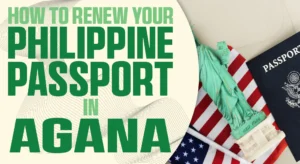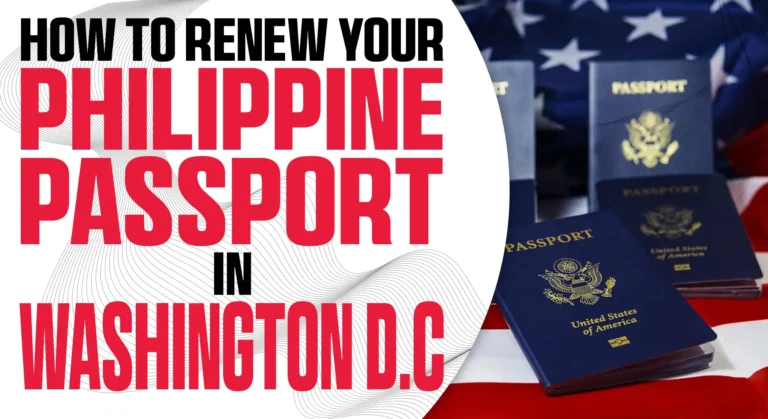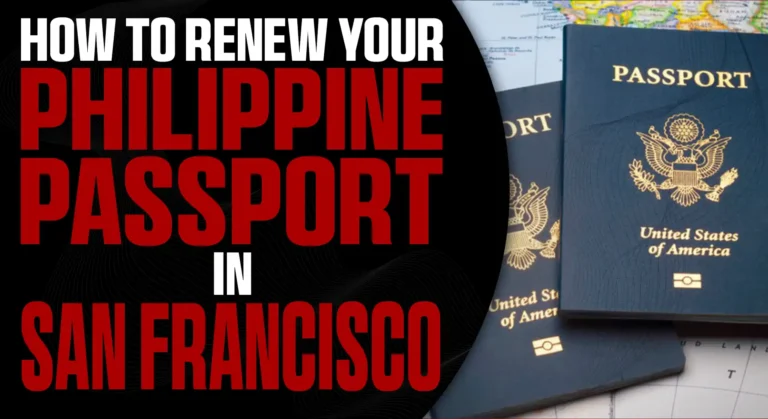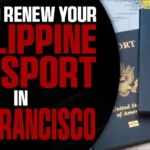How to Renew Your Philippine Passport in Agana
Your 2025 guide to Philippine passport renewal in Agana, Guam. Covers GOAS booking, document checklists, fees, and collection hours. Get prepared today!

For Filipino citizens residing abroad, a valid Philippine passport is the most critical document for identity, travel, and access to consular services. The process of renewing this vital document, while standardized in principle, involves specific local procedures that can vary significantly from one diplomatic post to another. This guide serves as a single, comprehensive, and authoritative resource for Filipino citizens under the jurisdiction of the Philippine Consulate General (PCG) in Agana, Guam, covering every facet of passport renewal and replacement.
The common challenge for applicants often lies in navigating a fragmented landscape of information, piecing together details from various official and unofficial websites, which can lead to confusion, delays, and unnecessary stress. This guide aims to eliminate that ambiguity by providing a clear, step-by-step roadmap. It synthesizes all necessary information into one cohesive document, addressing the unique blend of modern digital requirements and traditional on-site protocols specific to the Agana PCG.
This guide is intended for all Filipinos served by the Philippine Consulate General in Agana. Its consular jurisdiction extends beyond Guam to include the Commonwealth of the Northern Mariana Islands (CNMI), the Republic of Palau, the Federated States of Micronesia, and the Republic of the Marshall Islands. By following the detailed instructions herein, applicants can approach their passport renewal with confidence and clarity, ensuring a smooth and successful process.
Philippine Consulate General in Agana
To prevent confusion from outdated or conflicting information found across the web, this table consolidates the verified contact and operational details for the Philippine Consulate General in Agana. This serves as a single source of truth for all applicants.
| Category | Details |
|---|---|
| Physical Address | Suite 601, ITC Building, 590 S. Marine Corps Drive, Tamuning, Guam 96913 |
| Mailing Address | P.O. Box 9880, Tamuning, Guam 96931 |
| Official Website | https://aganapcg.dfa.gov.ph/ |
| Operating Hours | Monday – Friday, 9:00 AM – 5:00 PM (Closed on holidays) |
| Passport Releasing Hours | Monday – Friday, 4:00 PM – 5:00 PM ONLY |
| Main Phone Numbers | (671) 646-4620, (671) 646-4630 |
| Email Addresses | agana.pcg@dfa.gov.ph, pcgagana@gmail.com |
| 24/7 Emergency Hotline | +1 (671) 488-4630 (For genuine emergency cases ONLY) |
The Gateway to Renewal
The Non-Negotiable First Step
The journey to renewing a Philippine passport begins with a single, mandatory step: securing a confirmed online appointment. The Department of Foreign Affairs (DFA) has implemented a global policy requiring all applicants for any passport service—be it a first-time application, standard renewal, or replacement of a lost or damaged passport—to book a slot in advance. The Agana PCG strictly adheres to this rule; walk-in applicants seeking passport services will not be accommodated.
Identifying the Correct Portal
A critical point of potential confusion is the existence of multiple booking platforms. It is imperative that applicants use only the official, centralized portal for passport services.
Direct all booking activities to the DFA’s Global Online Appointment System (GOAS), accessible at: www.passport.gov.ph.
Applicants must explicitly avoid using the Agana PCG’s separate booking site on the Setmore platform (bookmeaganapcg.setmore.com). That system is designated exclusively for non-passport consular services, such as civil registration (reports of birth, marriage, death) and notarization or legalization of documents. Attempting to book a passport appointment through this secondary portal will result in a misdirected effort and a failed attempt to secure a valid slot. This distinction highlights a crucial aspect of the consulate’s operations: a hybrid model that combines a modern, global digital platform for passport appointments with localized systems for other services.
Step-by-Step Guide to Booking on GOAS
Securing an appointment through the GOAS portal is a straightforward process when followed correctly:
- Access the Portal: Navigate to www.passport.gov.ph and choose to schedule a new appointment.
- Select the Location: This is a multi-step selection. Applicants must choose the correct region, country, and site. For the Agana Consulate, the sequence is:
- Region: North America
- Country: United States of America
- Site: Agana PCG
- Choose a Date and Time: The system will display a calendar with available dates. Select a preferred date and time slot from the options provided.
- Complete the Application Form: Fill out the online form with accurate personal information. Double-check all entries for correctness, as this data will be used to pre-populate the application form.
- Await Confirmation: After successfully submitting the form, the system will send a confirmation to the email address provided. This email is vital, as it contains the complete application packet, including a checklist of requirements, the pre-filled application form with a unique barcode, and the e-receipt. It is strongly recommended to use a valid Gmail or Yahoo email address, as other providers like Hotmail or MSN have been known to have compatibility issues with the GOAS system.
Expert Tips for Securing an Appointment
Passport appointment slots are in high demand and are often filled quickly. While the DFA generally releases new slots at scheduled times (typically noon and 9:00 PM, Philippine Standard Time), it is best to check the portal frequently. For families applying together, the GOAS platform offers a group appointment feature, which can streamline the booking process.
The structure of the Agana PCG’s process demonstrates a reliance on a centralized digital gateway (GOAS) for entry, but this modern front-end transitions to a more traditional, analog system for on-site procedures, particularly financial transactions. The DFA has effectively standardized the initial point of contact for passport applicants worldwide, ensuring a uniform start to the process. However, the execution of services at the individual consular posts retains local autonomy. While other consulates in the U.S. and Canada have embraced digital payments , the Agana PCG maintains a strict policy against them. This divergence creates a potential pitfall for the unprepared applicant. It is a mistake to assume that the modern online appointment system signifies a fully digitized process from start to finish. This guide is designed to bridge that expectation gap, preparing applicants for the specific analog realities of the on-site procedures at the Agana consulate.
Document Checklists for Every Applicant
The Primacy of PSA Documents
Before assembling any documents, it is essential to understand a foundational principle of the Philippine consular system: the Philippine Statistics Authority (PSA) is the ultimate arbiter of civil identity. All personal details on a new passport—name, date of birth, place of birth—will strictly conform to the information on the applicant’s PSA-issued documents.
Therefore, any errors, inconsistencies, or desired changes on a birth certificate or marriage certificate must be legally rectified through the PSA before scheduling a passport appointment. The consulate cannot make changes that are not supported by an official, PSA-annotated document. For convenience, applicants can order certified PSA documents online through official channels like psahelpline.ph or psaserbilis.com.ph.
Standard Adult Renewal (e-Passport)
For a straightforward renewal of an existing electronic passport (e-Passport), applicants must prepare the following:
- Confirmed Online Appointment: The printed confirmation email from the GOAS, which includes the application packet.
- Accomplished Application Form: This form, which is part of the email packet, should be reviewed for accuracy. While it is pre-filled, a blank downloadable version is often available on consulate websites for reference.
- Personal Appearance: This is mandatory for all applicants, regardless of age, to facilitate the capture of biometric data (photograph and fingerprints).
- Current e-Passport: The applicant’s original, current passport must be presented for cancellation.
- Photocopy of Data Page: One clear, legible photocopy of the data page of the current passport.
- Proof of Status: The original and one photocopy of the applicant’s proof of legal status in the United States, such as a Permanent Resident Card (Green Card) or a valid U.S. visa.
Renewal for Minors (Under 18)
Applicants under the age of 18 must provide all the standard adult requirements listed above, with the following crucial additions:
- Personal Appearance of Minor and Parent/Guardian: The minor applicant must appear in person, accompanied by at least one parent or a court-appointed legal guardian.
- Proof of Filiation: The original and one photocopy of the minor’s PSA-issued Certificate of Live Birth or Report of Birth. This document establishes the legal relationship between the child and the accompanying parent.
- Parent/Guardian’s Passport/ID: The original and one photocopy of the valid passport or other government-issued photo ID of the accompanying parent or legal guardian.
- Parental Marriage Certificate: If the minor is accompanied by only one parent, the consulate may require the parents’ PSA-issued Marriage Certificate to further establish parental authority.
- Legal Documents for Guardians/Companions: If the minor is accompanied by an adult who is not a parent, a Special Power of Attorney (SPA) executed by the parent(s) and an Affidavit of Consent are required. These legal documents must be properly notarized.
Replacing a Lost or Damaged Passport
The loss or mutilation of a passport is treated with greater scrutiny and requires a more extensive set of documents. The process is handled as a new application, not a simple renewal, and thus requires a confirmed online appointment.
The documentation requirements reveal a clear hierarchy of proof within the consular system. The PSA certificate serves as the foundational document of a citizen’s core identity. This is followed by the previous passport, which is the primary evidence of travel identity, and then supplemented by other government-issued IDs. When a higher-tier document is compromised, such as a lost passport, the system requires the applicant to re-establish their identity from the ground up by providing stronger evidence from the lower tiers, namely the original PSA birth certificate and multiple valid IDs. For a simple renewal, the current passport suffices as the main document. However, for a lost passport, the process reverts to the more stringent requirements of a first-time applicant, demanding the foundational civil registry documents. This underscores the importance for all Filipinos abroad to maintain secure, accessible, original copies of their PSA certificates as the ultimate fallback for identity verification.
Checklist for LOST Passports
- All Requirements for a New Applicant: This includes the original PSA-issued Birth Certificate and valid government-issued photo IDs. If available, a photocopy of the lost passport’s data page is extremely helpful and highly recommended.
- Notarized Affidavit of Loss: An original, duly notarized affidavit that details the circumstances surrounding the loss of the passport. Templates for this affidavit are often available for download from the websites of Philippine consulates.
- Police Report: If the lost passport was still valid at the time of loss, an original police report, translated into English if necessary, is mandatory. This requirement is waived if the lost passport had already expired.
- Additional Clearing Period: Applicants must be aware that the replacement of a lost valid e-Passport is subject to a mandatory 15-calendar-day clearing period. This is in addition to the standard processing time and cannot be waived.
Checklist for DAMAGED/MUTILATED Passports
- All Requirements for a Standard Renewal.
- Surrender Damaged Passport: The applicant must submit the original damaged or mutilated passport.
- Notarized Affidavit of Explanation: An original, notarized affidavit explaining in detail how the passport came to be damaged or mutilated.
Your Appointment at the Consulate
Pre-Appointment Preparation
Thorough preparation is the key to a successful and efficient appointment. Before heading to the consulate, applicants should organize all original documents and their corresponding photocopies into a single folder or envelope for easy presentation and evaluation. It is also wise to bring a black-ink pen for signing forms or filling out any additional paperwork that may be required on-site.
The On-Site Process
The procedure at the consulate follows a logical, sequential workflow. Understanding this flow can help manage expectations and reduce anxiety on the day of the appointment.
- Arrival and Check-in: Upon arrival at the scheduled time, present the printed appointment confirmation packet to the consular staff at the entrance.
- Document Evaluation: This is the most critical stage of the process. The applicant will be called to a counter to submit their folder of documents. A consular officer will meticulously evaluate each document for completeness, authenticity, and compliance with all requirements. This step functions as a crucial gate; an applicant cannot proceed further until their documents are deemed to be in perfect order.
- Payment of Fees: Once the documents have been verified and approved, the applicant will be directed to the Cashier’s window to pay the applicable fees.
- Biometric Data Capture: After payment, the applicant will present the official receipt at the Passport Encoding Counter. Here, their digital photograph will be taken and their fingerprints will be scanned and captured electronically.
- Final Data Verification: Before the process is finalized, the applicant will be shown a screen with all their encoded biographic data. It is imperative to review every detail—name spelling, date of birth, place of birth—for accuracy. Once the applicant confirms the data is correct, the application is submitted electronically to the central printing facility in the Philippines.
The on-site process is deliberately structured as a linear progression. The explicit instruction that an applicant proceeds to the cashier only “when your documents are found to be in order” reveals a system designed for maximum efficiency. This conditional advancement prevents the workflow from being congested by applicants with incomplete or incorrect paperwork. It ensures that only fully vetted applications move on to the payment and biometric stages. The clear implication is that an applicant’s success is largely determined by their preparation before arriving at the consulate. The appointment itself is merely the execution of a well-prepared plan. Therefore, the focus should be less on “what to do on the day” and more on “how to be perfectly prepared for the day.”
Consulate Etiquette and Dress Code
Presenting oneself appropriately is a sign of respect for the consular process and is required for the biometric photo.
- Attire: Applicants must wear proper, modest clothing. A shirt with a collar and sleeves is required. T-shirts without collars, tank tops, spaghetti straps, and plunging necklines are not permitted.
- Appearance for Photo: For the biometric photograph to be accepted, applicants must remove all accessories from the head and neck area. This includes earrings, necklaces, and facial piercings. Additionally, colored contact lenses and eyeglasses must be removed during the photo capture.
- Conduct: The consulate enforces a strict “No Escort” policy. Only the applicant is permitted to enter the consular premises. Exceptions are made for minors (who must be accompanied by a parent/guardian), senior citizens, and persons with disabilities (PWDs) who require assistance.
Financials and Timelines
Passport application fees are fixed and vary depending on the type of service required. Applicants should prepare the exact amount to avoid any delays at the cashier. The costs for services at the Agana PCG are as follows:
| Service Type | Fee (in US Dollars) |
|---|---|
| Passport Renewal (e-Passport) | $60.00 |
| Replacement of Lost e-Passport | $150.00 |
| Replacement of Lost non-ePassport | $90.00 |
| Replacement of Damaged/Mutilated Passport | $60.00 |
| Notarization Fee (per document, e.g., Affidavit) | $25.00 |
Note: Fees for lost or damaged passports are in addition to the cost of the required notarized affidavit.
Accepted Payment Methods: A Critical Local Detail
This is one of the most important local-specific details that applicants must be aware of. The Philippine Consulate General in Agana has a restrictive payment policy. Payment is accepted only in the following forms:
- Cash (in U.S. Dollars)
- Postal Money Order
- Bank Draft
- Certified Check
- Cashier’s Check
Crucially, the consulate does not accept personal checks or any form of credit or debit card payment. This is a significant point of divergence from other Philippine diplomatic posts, such as the Embassy in Washington, D.C., and the Consulate in Toronto, which have modernized their systems to accept digital payments. Applicants arriving at the Agana PCG with only a credit card will be unable to complete their transaction and will have their application process halted.
The 4-6 Week Wait: Managing Expectations
Patience is a key component of the passport renewal process. The standard processing time for a new passport to be printed, shipped from the Philippines, and become available for release in Guam is approximately 4 to 6 weeks, or up to 45 days from the application date.
It is vital for applicants to understand that there is no expedited processing option available at the Agana PCG or any other foreign service post. All passport booklets are centrally printed and produced in the Philippines to ensure security and uniformity, making expedited service impossible. Applicants are strongly advised to factor this timeline into their plans and to wait until they have their new passport in hand before purchasing non-refundable international airline tickets. For cases of extreme emergency requiring immediate travel to the Philippines (e.g., a medical or family crisis), applicants may apply for a one-time use Travel Document (TD), which is valid for a single journey to the Philippines within one month of its issuance.
The Final Step: Claiming Your New Passport
How to Verify Your Passport is Ready
After the 4-6 week waiting period, applicants should not go to the consulate without first verifying that their passport has arrived. The Agana PCG maintains an online list of passports that are ready for collection. Applicants should monitor the consulate’s official website for a link, typically labeled “List of Passports Available for Release,” which usually directs to a regularly updated Google Spreadsheet.
The Collection Process: Hours and Requirements
The consulate’s operational procedures are distinctly separated for applications and collections. This “decoupling” is likely designed to streamline workflow by preventing collection activities from interrupting the more complex and time-consuming application appointments during main business hours. This means applicants must interact with the consulate under two different sets of rules.
Dedicated Collection Hours
Passport releasing has a specific, dedicated window of time. Collection is available from Monday to Friday, between 4:00 PM and 5:00 PM only, excluding holidays. Applicants attempting to collect their passport outside of this one-hour window will not be entertained.
No Appointment Needed for Collection
Unlike the application process, no appointment is necessary to claim a new passport. Applicants whose names appear on the release list can proceed directly to the consulate during the designated collection hour.
What to Bring for Personal Collection
To claim the new passport in person, the applicant must bring:
- Original Old Passport: The current or most recent passport must be presented for cancellation. The consulate will not release the new passport without canceling the old one.
- Official Receipt: The original receipt issued at the time of application.
- Valid Photo ID: It is advisable to also bring a valid photo ID for verification purposes.
Authorizing a Representative to Pick Up Your Passport
If an applicant is unable to collect their passport in person, they may authorize a representative. The representative must present the following documents:
- The applicant’s original old passport for cancellation.
- A formal Authorization Letter signed by the passport owner.
- A clear photocopy of the representative’s valid government-issued ID.
Immediate Actions Upon Receipt
The process is not complete until the applicant takes a few final, crucial steps:
- Verify All Details: Before leaving the consulate, meticulously inspect the new passport’s data page. Check for any typographical errors in the name, date of birth, or other personal information. If any discrepancy is found, it must be reported to the consular staff immediately.
- Sign Your Passport: An unsigned passport is not valid for travel. Immediately upon receipt, the owner must affix their signature on the designated line on the third page of the passport booklet.
- Safeguard Your Document: Make high-quality photocopies or digital scans of the passport’s data page. Store these copies separately from the original passport, both at home and while traveling.
Consular Outreach Missions
Extending Consular Services
Recognizing the geographical spread of its jurisdiction, the Agana PCG regularly conducts Consular Outreach Missions to bring its services closer to Filipino communities in other islands. These missions frequently visit locations such as Koror, Palau, and Saipan, CNMI.
The Application Process for Outreach Missions
Applying for a passport during an outreach mission is not a walk-in process. It follows the exact same online appointment procedure as an application at the consulate in Guam.
When booking through the GOAS portal at www.passport.gov.ph, applicants must be careful to select the specific outreach mission as their chosen “Site.” For example, an applicant in Palau would look for a site named “Agana PCG – Outreach in Koror, Palau” on the GOAS calendar. Slots for these missions are limited and must be secured in advance.
Staying Informed
The schedules, locations, and available services for all consular outreach missions are announced publicly. Applicants residing outside of Guam should regularly monitor the “Announcements and Advisories” section of the Agana PCG’s official website (aganapcg.dfa.gov.ph) to stay informed about upcoming missions in their area.
Conclusion
The process of renewing a Philippine passport at the Consulate General in Agana, while detailed, is entirely manageable with diligent preparation. Success hinges on a clear understanding of the key procedural pillars. By adhering to the steps outlined in this comprehensive guide, applicants can navigate the system with confidence and avoid common pitfalls.
To ensure a seamless experience, the most critical actions can be summarized as follows:
- Book Online Correctly: Use only the official GOAS portal (www.passport.gov.ph) to secure a mandatory appointment.
- Prepare Documents Meticulously: Assemble all required original documents and photocopies, with a particular focus on ensuring all civil registry records are official, error-free copies from the Philippine Statistics Authority.
- Bring the Right Payment: Arrive with the exact fee in an accepted format—cash, postal money order, or certified/cashier’s check—as credit cards and personal checks are not accepted.
- Plan for the Wait: Factor the non-negotiable 4-to-6-week processing time into any travel plans and avoid booking flights until the new passport is in hand.
- Collect During the Designated Hour: Check the online release list and claim the new passport only during the specific 4:00 PM to 5:00 PM window, bringing the old passport for cancellation.







